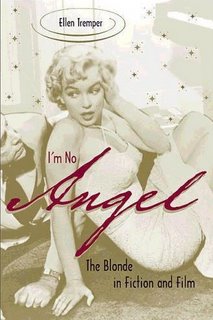
Probably it was hard to imagine that Marilyn Monroe (or Mae West) and the Brontës could someday share a post on this blog, but the appearance this month (in hardback and paperback) of
I'm no angel: The Blonde in Fiction and Film (Virginia University Press) has performed the miracle.
The book is written by Ellen Tremper.
Have you ever wondered why there are so many "dumb blonde" jokes—always about women? Or how Ivanhoe's childhood love, the"flaxen Saxon" Rowena, morphed into Marilyn Monroe? Between that season in 1847 when readers encountered Becky Sharp playing the vengeful Clytemnestra—about to plunge a dagger into Agamemnon—and the sunny moment in 1932 when moviegoers watched Clark Gable plunge Jean Harlow's platinum-tressed head into a rain barrel, the playing field for women and men had leveled considerably. But how did the fairy-tale blonde, that placid, pliant girl, become the "tomato upstair," as Monroe styled herself in The Seven Year Itch?
In I'm No Angel: The Blonde in Fiction and Film, Ellen Tremper shows how, at its roots, the image of the blonde was remodeled by women writers in the nineteenth century and actors in the twentieth to keep pace with the changes in real women's lives. As she demonstrates, through these novels and performances, fair hair and its traditional attributes—patience, pliancy, endurance, and innocence—suffered a deliberate alienation, which both reflected and enhanced women's personal and social freedoms essential to the evolution of modernity. From fiction to film, the active, desiring, and sometimes difficult women who disobeyed, manipulated, and thwarted their fellow characters mimicked and furthered womenís growing power in the world. The author concludes with an overview of the various roles of the blonde in film from the 1960s to the present and speculates about the possible end of blond dominance. The book includes a chapter with this title:
-Brontë & Elliot: Blond transformations.We at the BrontëBlog have been discussing who are the Brontë blondes that the author have in mind: we remember Catherine Linton (daughter), Isabella Linton, Ginevra Fanshawe... but we're not at our best. Any ideas?
Categories: Books, Scholar
 Probably it was hard to imagine that Marilyn Monroe (or Mae West) and the Brontës could someday share a post on this blog, but the appearance this month (in hardback and paperback) of I'm no angel: The Blonde in Fiction and Film (Virginia University Press) has performed the miracle.
Probably it was hard to imagine that Marilyn Monroe (or Mae West) and the Brontës could someday share a post on this blog, but the appearance this month (in hardback and paperback) of I'm no angel: The Blonde in Fiction and Film (Virginia University Press) has performed the miracle.

Adele is blond, and St.John's fair looks cause Mr Rochester much despair in the closing chapters.
ReplyDeleteAh, well, then we weren't so lost after all!
ReplyDeleteThanks :)
I wonder if you will see this but:
ReplyDeleteThank you for your comment! Unforgettable blondes both of them!
Of course seeing the new actress cast for Jane Eyre 2006 as Blanche Ingram we see they have stuck to her being a blonde instead of a brunette, as Charlotte would have it.